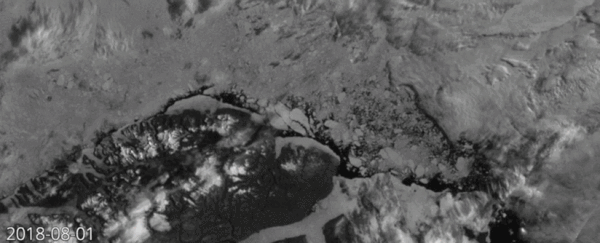The breakdown of some of the oldest and thickest sea ice in the Arctic has occurred for the first time in recorded history. Not once, but twice this year, the breaking ice has opened waters north of Greenland that are usually frozen even in summer.
It's partially the result of climate change-driven heatwaves and warm winds that have swept the Northern Hemisphere this year, and among the short-term consequences, it could threaten the survival of Arctic seals and polar bears, scientists say.
Satellite imagery from NASA Worldview has shown the ice, which has become brittle and mobile, retreating back from the Northern coast of Greenland, blown aside by the wind in early August. This exposed a swath of sea that had previously been completely covered.
"The fact that it has become mobile shows it is thinner than it used to be and this last holdout of heavy ice is now becoming as mobile as any other part of the Arctic," physicist Peter Wadhams, director of the Polar Ocean Physics Group at Cambridge University, told The Independent.
"In the past, most of the ice in the Arctic has been multi-year ice, but that has been shrinking and now nearly all the ice in the Arctic is first-year ice.
"The only zone where multi-year ice has survived is north of Greenland, but this last holdout is now opened up and moving away from the coast."
This region has been where climate scientists believe the last of the perennial ocean ice will linger. But now that it's retreating, they may have to reconsider which part of the Arctic they believe will survive climate change the longest.
The ice there is usually extraordinarily thick and compacted. It's pushed by the Transpolar Drift Stream, one of the major currents of the Arctic Ocean, which transports ice all the way from Siberia and shoves it up next to Greenland.
"The ice there has nowhere else to go so it piles up," climate scientist Walt Meier of the US National Snow and Ice Data Center told The Guardian.
"On average, it's over 4 metres (13 feet) thick and can be piled up into ridges 20 metres (67 feet) thick or more. This thick, compacted ice is generally not easily moved around."
However, unusually warm conditions earlier this year in February, and now again in August, have thinned the ice to a degree that it can be pushed by the wind.
Just before the August event, the Kap Morris Jesup weather station registered a record high of 17 degrees Celsius (62.6 Fahrenheit). Norwegian Ice Service data also show that ice cover in the Arctic is 40 percent below the average for this time of year.
This could devastate the local polar bear population, Wadhams said, as the steep cliffs on the north coast of Greenland is where a lot of the animals have their dens.
"They dig holes in the snow and come out in the spring and go hunting. But if the pack ice has moved offshore, they come out hibernation and are left without an area to hunt," he told The Independent.
"They can't swim very far. If this becomes a permanent feature with ice away from the coast, polar bears won't have any ice to hunt on. You would lose the polar bear habitat."
Other populations impacted could include seals, and local Indigenous groups that use the area for fishing. And there will be long-term effects too. Although the area will freeze over again, it will be later than usual.
And the old, thick, multi-year sea ice is gone, pushed out into open waters.
The sea ice is not quite at its lowest recorded extent. That occurred in September 2012. However, it's getting close. In March of this year, the extent of the sea ice was the second-lowest on record for winter.
And, according to NASA data, September Arctic sea ice - when it is typically at its lowest - is declining at a rate of 13.2 percent per decade.
This week, NASA's Oceans Melting Greenland project will be returning to the Arctic waters around Greenland for its third year in a row gathering data on the frozen ecosystem, and how the oceans around Greenland are melting its glaciers.
